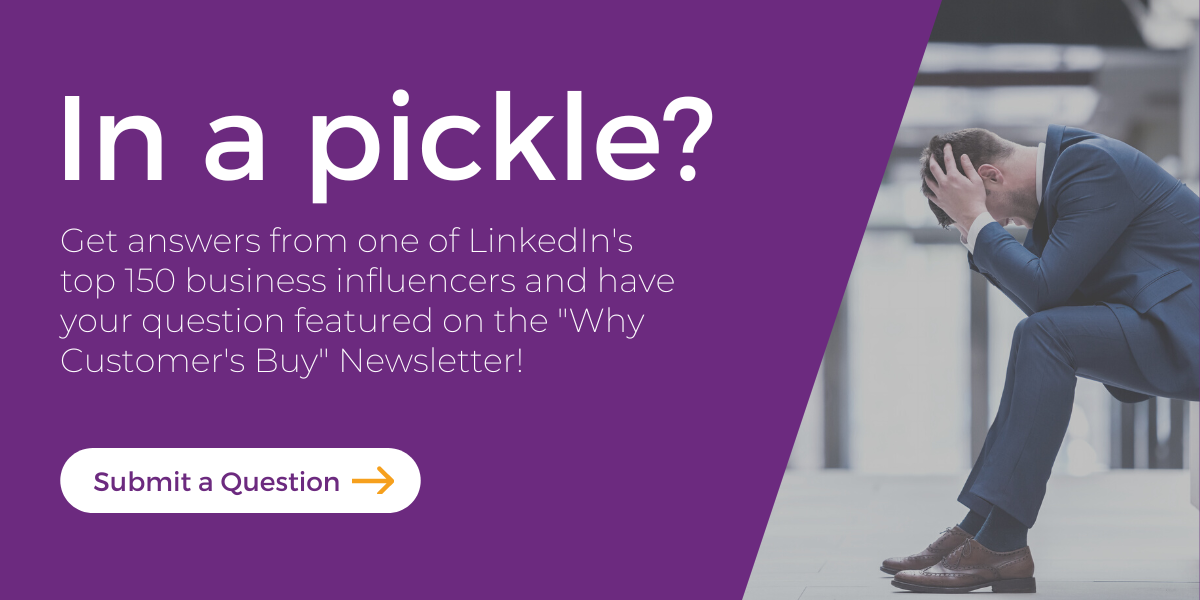I was at a drugstore standing before the vitamin shelves the other day. There are hundreds of bloody vitamin options. It got me thinking about how these various vitamin companies differentiate themselves and how that applies to non-vitamin-providing organizations, too.
(To be fair, one vitamin bottle caught my attention. In large text, it read “Chillax.” But I will get back to that in a minute.)
Vitamin companies are not the only ones that struggle to differentiate themselves. One of our podcast listeners wrote in with a business pickle, asking how to differentiate their offering and experience from the competition. So, I thought we would talk about this here, too, because many of you probably are wondering the same thing. ]
Watch Colin talking about this on YouTube:
Subscribe to our YouTube channel here to see all the latest videos!
Differentiation is a funny thing. It is hard to figure it out when you are too close to something. You focus on what you know about it instead of why what you know matters to other people.
For example, Vitamin B12 has many exciting attributes. Known also as Cobalamin, it is critical to forming red blood cells, metabolic rate for cells, and your nerve function. Also, it aids in producing your DNA. The recommended dose is about 2.4 micrograms for adults, per the Mayo Clinic. It is rare for people in the US to have a B12 deficiency, but some do, particularly those who don’t eat meat or older people who do not absorb nutrients like they used to. These people might want a vitamin supplement.
Several vitamin companies offer B12 vitamins. But will those various manufacturers have a differentiating factor that attracts buyers to choose their bottle over the one next to it?
Probably not. B12 is the same, regardless of its bottle.
So, to differentiate, the vitamin companies would need to get outside of their bottle and more into the vitamin experience.
I mentioned earlier that one of the vitamin companies caught my attention. It was the one with the big Chillax on it. For those unfamiliar with the vocabulary, Chillax combines the words “chill” and “relax.” It means to calm down. So, that bottle wasn’t selling the vitamin to me; it was selling what the vitamin was going to do for me.

The Five Rules to Differentiate Your Experience
In anticipation of this discussion on the podcast, we came up with five rules. So, here they are:
- Different means different, not “just a bit” different.
- Be innovative and disruptive.
- Define the Who and the How Much.
- Define the What.
- Experience is the hardest to copy.
Let’s take a close look at each of these:
Rule #1: Different means different, not “just a bit” different.
I started here because it is essential to note that it’s not about copying others and making slight changes around the edges of the offering. This problem also happens when organizations adopt some best practices for their industry. If everyone does the same best practices, there is less to differentiate. Sure, it gets you up to the level of the other players in your industry, but it is not an innovation strategy.
For example, if the B12 vitamins you have at .001 percent purer than the others, that’s great. However, it’s hard to get excited about that for most people. Leading with that in your branding strategy is too hard for people to understand the significance. So, it’s not different enough.
The danger is if you just do the little bits, somebody can quickly come along and copy them. They’re not going to give you a significant change.
Rule #2: Be innovative and disruptive.
Significant improvements often come from outsiders to a given area of business. They come in with a new approach to business as usual. Usually, this occurs after commoditization has made it challenging to be that different from the competition due to participating in a mutually agreed-upon market structure. Instead of disrupting, the players are all chasing little differences with these spaces.
Competitors knock down the wall, which has become a barrier to differentiation. The book Blue Ocean Strategies makes this argument, too. Companies can limit their thinking by competing in the same ways firms always have.
We think more companies should think like Lego (and you thought we were going to say Apple…). They have a plastic brick; it doesn’t even have a patent anymore, so anyone can produce it. Talk about commoditization. However, they have differentiated that experience, and people pay a lot for it.
One of the ways you can disrupt or innovate is to personalize things. Business has discussed personalization for ages, but most organizations still don’t. However, personalizing the experience with those small things makes a big difference.
Rule #3: Define the Who and the How Much.
Knowing your market is crucial. Understanding which customers you interact with helps your firm provide a differentiated experience that matters to those customers. The same experience will be fantastic or terrible, depending on who it is having it.
Since we brought up Lego, let’s keep going with that. Many years ago, Lego had models you could build, but afterward, you would take them apart and build something else. Now, you buy a Lego set, build it, and display it on a shelf. You could take it apart and make something else, and some people probably still do, but the idea is that you built a model and then admired your work.
Lego recognized that there was a different segment of its customers. These customers wanted to display their beautiful creations after painstakingly pouring over the instructions provided. That means there were a lot more specialized pieces, which were perhaps not so great for building something else. Maybe that meant these kits weren’t as great for the creative builders.
However, that was a deliberate choice Lego made. Lego recognized that there are different segments in the market, and by catering to them, they can charge a premium for what they are doing.
Moreover, they have Legos for different age groups, from toddlers to adults. They also have Legos for Star Wars, Marvel, and Harry Potter enthusiasts. These other groups of people want different things out of the Lego experience.
The other part of this rule is defining How Much. This second part refers to determining how much you will gain from making the change.
So, if you go to the financial teams, they want to know the revenue you will pull in, the costs involved, and how that works out. This part of the rule is for them and you. Determining how differentiation for the Who will create value in the How Much is essential.

Rule #4: Define the What.
So, now that you know the Who and the How Much, you need to know the What. By that, we mean what you are going to differentiate. Is it the brand or the product, or the experience?
Ideally, it would be everything. The vitamin companies would probably have to say the labels, which are a bit of brand and experience because we all know the product is what it is.
For example, since ChatGPT came out, a new AI pops up every day. These models can do great things also, but ChatGPT has the mindshare; people know the name because they were first. They’re the ones that everybody thinks about.
So, other engines may be just as good or even better. Still, the significant differentiation between ChatGPT and many other AI services is primarily branding. It’s that we know about them.
Rule #5: Experience is the hardest to copy.
In our humble (and unbiased opinion), you can differentiate yourself effectively by differentiating your experience. You can even do it with the company mindset.
For example, if you get everyone in the organization into a customer-centric mindset, which is no small achievement, and your competition doesn’t for a couple of years, you are ahead of them. So long as you continue to progress in your thoughts, you will maintain that advantage. The experience you give your customers will continue to differentiate you more than the competition’s efforts.
Also, experience has a better defense against customer churn. So, let’s suppose a customer has chosen you based on price. If they see a better price, they will leave and try it.
However, if a customer chooses you for the experience provided, they won’t leave to try another one because they like the experience they are having. They don’t care to find out what the other experience is like. Your job is to keep up the excellent work in this situation.
Too few organizations differentiate themselves enough. They might be wise to consider what they could learn from Lego or any other successful market leader in an industry.
The point is these things matter, from making sure you are different to finding ways to innovate or disrupt to defining the Who, What, and How Much, to realizing the experience is the hardest thing for other companies to copy. We hope they can help our listeners—and you—differentiate their experiences from the competition.
And take your B12, will you?

If you have a business problem that you would like some help with, contact me on LinkedIn or submit your pickle here. We would be glad to hear from you and help you with your challenges.


